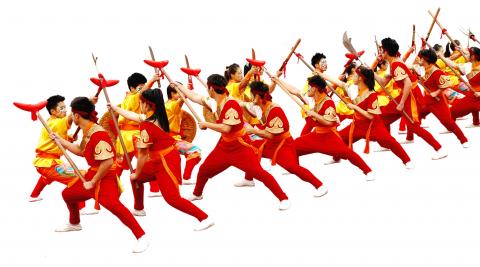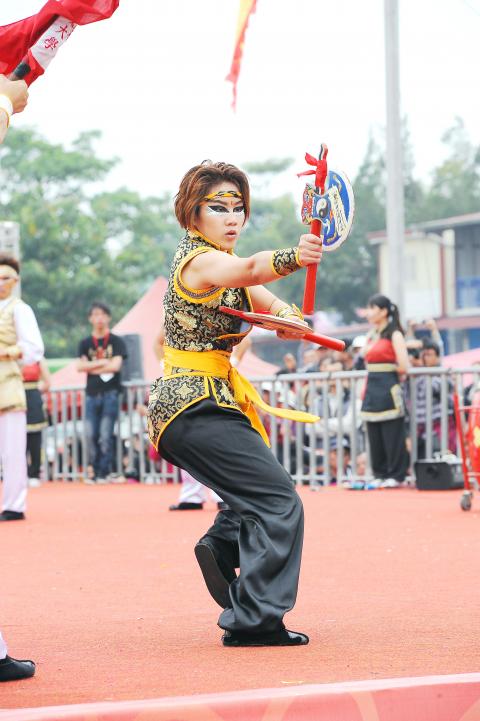This weekend, thousands of martial arts fans are expected to descend on Greater Kaohsiung’s Neimen District (內門) to watch a week-long lineup of Song-Jiang Jhen Battle Array (宋江陣), a form of performing arts that combines elements of kung fu, dance and drumming.
The festival, now in its 12th year, invites martial arts troupes from home and abroad to showcase their best moves. Groups of college students will also take part in a creative competition, which is aimed at revitalizing the tradition.
Originating over a century ago, the battle array was named after Song Jiang (宋江), leader of a group of bandits who lived during the Song Dynasty. In training his henchmen, Song would divide them into two groups and have each person carry a weapon. A round of mock duels would then follow.

Photos Courtesy of Kaohsiung City Government
The method was so successful in preparing the men for battle, it was later adopted as a regular military exercise to boost defense capability and ward off pirates, bandits and neighboring clans. A wide variety of weapons, strategies, formations and music were applied to make the exercise more challenging.
Over the years, the battle array has transformed itself into a ritual that is performed in temples to honor the birthdays of deities. Today, temples in southern Taiwan organize the performance teams themselves. Although a full-size team consists of 107 members, it is more common to see a 72 or 36-member array.
Recognizing that the custom has been slowly dying out, the Kaohsiung City Government, in cooperation with local temples, has been holding a series of activities in Neimen to revive interest in the performance art.

Photos Courtesy of Kaohsiung City Government
“Neimen is a special place … Its population stands at 15,000, but it has 50 to 60 martial arts performance troupes,” said Deputy Mayor Lee Yung-te (李永得) at a press conference held to launch the annual festival.
Many uprisings took place in Neimen in the past, including a large scale anti-Manchu protest led by Chu Yi-kuei (朱一貴) in the early 18th century. Neimen people’s valor and courage both in the past and present contributed greatly to Taiwan’s battle array culture, he said.
Introducing the battle array as an art that integrates sports and music, Lee said that the event is a great way to experience Taiwan’s rich cultural heritage. Photo exhibitions, calligraphy shows and a culinary extravaganza will also be held alongside the performances. Complete details in Chinese and English can be found at: www.who-ha.com.tw.

Most heroes are remembered for the battles they fought. Taiwan’s Black Bat Squadron is remembered for flying into Chinese airspace 838 times between 1953 and 1967, and for the 148 men whose sacrifice bought the intelligence that kept Taiwan secure. Two-thirds of the squadron died carrying out missions most people wouldn’t learn about for another 40 years. The squadron lost 15 aircraft and 148 crew members over those 14 years, making it the deadliest unit in Taiwan’s military history by casualty rate. They flew at night, often at low altitudes, straight into some of the most heavily defended airspace in Asia.

Taiwan’s democracy is at risk. Be very alarmed. This is not a drill. The current constitutional crisis progressed slowly, then suddenly. Political tensions, partisan hostility and emotions are all running high right when cool heads and calm negotiation are most needed. Oxford defines brinkmanship as: “The art or practice of pursuing a dangerous policy to the limits of safety before stopping, especially in politics.” It says the term comes from a quote from a 1956 Cold War interview with then-American Secretary of State John Foster Dulles, when he said: ‘The ability to get to the verge without getting into the war is

Many people in Taiwan first learned about universal basic income (UBI) — the idea that the government should provide regular, no-strings-attached payments to each citizen — in 2019. While seeking the Democratic nomination for the 2020 US presidential election, Andrew Yang, a politician of Taiwanese descent, said that, if elected, he’d institute a UBI of US$1,000 per month to “get the economic boot off of people’s throats, allowing them to lift their heads up, breathe, and get excited for the future.” His campaign petered out, but the concept of UBI hasn’t gone away. Throughout the industrialized world, there are fears that

Like much in the world today, theater has experienced major disruptions over the six years since COVID-19. The pandemic, the war in Ukraine and social media have created a new normal of geopolitical and information uncertainty, and the performing arts are not immune to these effects. “Ten years ago people wanted to come to the theater to engage with important issues, but now the Internet allows them to engage with those issues powerfully and immediately,” said Faith Tan, programming director of the Esplanade in Singapore, speaking last week in Japan. “One reaction to unpredictability has been a renewed emphasis on